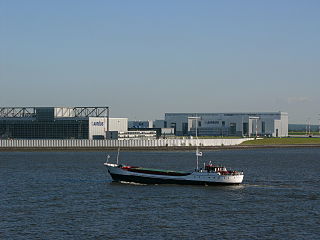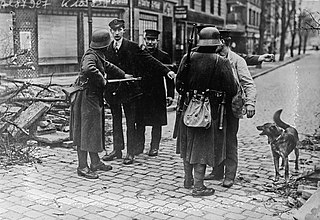
Blohm+Voss (B+V), also written historically as Blohm & Voss, Blohm und Voß etc., is a German shipbuilding and engineering company. Founded in Hamburg in 1877 to specialise in steel-hulled ships, its most famous product was the World War II battleship Bismarck. In the 1930s, its owners established the Hamburger Flugzeugbau aircraft manufacturer which, shortly before the outbreak of World War II, adopted the name of its parent company. Following a difficult period after the war, B+V was revived, changing ownership among several owners, as Thyssen Group and Star Capital. In 2016, it became a subsidiary of Lürssen and continues to supply both the military and civilian markets. It serves two areas – new construction of warships as NVL B.V. & Co. KG, and new construction and refitting of megayachts. The company has been in operation, building ships and other large machinery, almost continuously for 147 years.
Hamburger Flugzeugbau (HFB) was an aircraft manufacturer, located primarily in the Finkenwerder quarter of Hamburg, Germany. Established in 1933 as an offshoot of Blohm & Voss shipbuilders, it later became an operating division within its parent company and was known as Abteilung Flugzeugbau der Schiffswerft Blohm & Voss from 1937 until it ceased operation at the end of World War II. In the postwar period it was revived as an independent company under its original name and subsequently joined several consortia before being merged to form Messerschmitt-Bölkow-Blohm (MBB). It participates in the present day Airbus and European aerospace programs.

Neuengamme was a network of Nazi concentration camps in Northern Germany that consisted of the main camp, Neuengamme, and more than 85 satellite camps. Established in 1938 near the village of Neuengamme in the Bergedorf district of Hamburg, the Neuengamme camp became the largest concentration camp in Northwest Germany. Over 100,000 prisoners came through Neuengamme and its subcamps, 24 of which were for women. The verified death toll is 42,900: 14,000 in the main camp, 12,800 in the subcamps, and 16,100 in the death marches and bombings during the final weeks of World War II. Following Germany's defeat in 1945, the British Army used the site as an internment camp for SS and other Nazi officials. In 1948, the British transferred the land to the Free Hanseatic City of Hamburg, which summarily demolished the camp's wooden barracks and built in its stead a prison cell block, converting the former concentration camp site into two state prisons operated by the Hamburg authorities from 1950 to 2004. Following protests by various groups of survivors and allies, the site now serves as a memorial. It is situated 15 km southeast of the centre of Hamburg.

Airbus Hamburg-Finkenwerder, also known as Hamburg Finkenwerder Airport, is an aircraft manufacturing plant and associated private airport in the Finkenwerder quarter of southwest Hamburg, Germany. The airport is an integral part of the Airbus-owned plant, and is exclusively used by that company for corporate, freight, test, and delivery flights, including those of the former Airbus A380.

Jürgen Rohwer was a German military historian and professor of history at the University of Stuttgart. Rohwer wrote over 400 books and essays on World War II naval history and military intelligence, which gained him worldwide recognition as a prominent historian and a leading authority on U-boats.

Wenzendorf is a municipality in Lower Saxony, Germany. It is also the name of the chief village of the municipality.

Dessauer Ufer was a subcamp of the Neuengamme concentration camp in Nazi Germany, located inside the Port of Hamburg on the Kleiner Grasbrook in Veddel. It was in operation from July 1944 to April 1945. Inmates were mostly used for forced labour at rubble clearing and building in the Hamburg port area.

The Hamburg Uprising was a communist insurrection that occurred in Hamburg in Weimar Germany on 23 October 1923. A militant section of the Hamburg Communist Party of Germany launched an uprising as part of the so-called German October. Rebels stormed 24 police stations, 17 in Hamburg and seven in Schleswig-Holstein Province in Prussia, and established barricades around the city. The communist insurgency in Hamburg was futile, lacking support from the rest of Germany or from the Soviet Union, and disintegrated within a day. Around 100 people died during the Hamburg Uprising and the exact details of the event, as well as the assessment of its impact, remain controversial.

Kleiner Grasbrook is a quarter of Hamburg, Germany within the borough of Hamburg-Mitte. It is situated on the eponymous island between the Northern and Southern branches of the Elbe river, together with the other quarters of Steinwerder, Veddel and Wilhelmsburg. It almost exclusively consists of facilities of the port of Hamburg. The four quarters are technically all islands of their own, as they are all separated by their own dams. In 2020 the population was 1,120.
The Bästlein-Jacob-Abshagen Group was a German resistance group that developed around the core members Bernhard Bästlein, Franz Jacob and Robert Abshagen. It fought the National Socialist (Nazi) regime from 1940 till the end of the war in 1945. It consisted of about 300 members in over 30 groups in Hamburg factories, making it the biggest regional Nazi resistance group in the history of Hamburg.

Dr. Herbert Michaelis was a German lawyer and Communist, and a member of the German Resistance during the Third Reich.

Rudolf Querner was a German SS functionary during the Nazi era. He served as the Higher SS and Police Leader in Austria and Germany and was responsible for the evacuations and death marches from concentration camps at the end of the war. Arrested by the Allied authorities, he committed suicide in prison.

Steinwerder is a quarter of Hamburg, Germany in the borough Hamburg-Mitte on the southern bank of the river Elbe. It is a primarily maritime industrial location, with a resident population in 2017 of only 39.
The following is a timeline of the history of the city of Hamburg, Germany.

During World War II, the German Luftwaffe staffed dozens of concentration camps, and posted its soldiers as guards at many others. Camps created for the exploitation of forced labor for armaments production were often run by the branch of the Wehrmacht that used the products. The Wehrmacht also posted about 10,000 soldiers to concentration camps because of a shortage of guards in mid-1944, including many from the Luftwaffe.

Leitmeritz was the largest subcamp of the Flossenbürg concentration camp, operated by Nazi Germany in Leitmeritz, Reichsgau Sudetenland. Established on 24 March 1944 as part of an effort to disperse and increase war production, its prisoners were forced to work in the caverns Richard I and II, producing Maybach HL230 tank engines for Auto Union and preparing the second site for intended production of tungsten and molybdenum wire and sheet metal by Osram. Of the 18,000 prisoners who passed through the camp, about 4,500 died due to disease, malnutrition, and accidents caused by the disregard for safety by the SS staff who administered the camp. In the last weeks of the war, the camp became a hub for death marches. The camp operated until 8 May 1945, when it was dissolved by the German surrender.
Adolph Hermann Blohm was a German shipbuilder and company founder of Blohm+Voss.
The Hamburger Anzeiger, in circulation 1922–1957, was a daily newspaper for Hamburg and its neighbouring cities, which were incorporated in 1939.